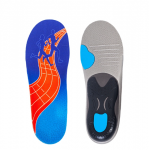please click here:
https://www.insolemaker.com/orthotic-insole.html
Introduction to Orthotic Insoles
Orthotic insoles are more than just shoe inserts. They are carefully engineered footbeds designed to provide structural support, reduce strain, and enhance overall foot biomechanics. Unlike standard cushioned insoles, orthotic insoles can alleviate pain, correct alignment issues, and prevent injuries caused by poor posture or repetitive stress. As people spend increasing hours on their feet at work, during sports, or simply while commuting, the demand for specialized orthotic insoles has grown steadily.
This article will explore what orthotic insoles are, how they function, the different types available, and how they compare to standard insoles. We will also review materials, manufacturing techniques, and the specific benefits they bring to individuals dealing with foot-related discomfort.
What Makes Orthotic Insoles Unique?
Orthotic insoles differ from basic shoe inserts in design and purpose. While mass-market insoles often focus on cushioning, orthotics address the root cause of foot pain by correcting structural imbalances. For example, people with flat feet or high arches often experience strain in the knees, hips, and lower back. Orthotic insoles redistribute weight, improve alignment, and ensure even pressure distribution.
Key Functions of Orthotic Insoles
-
Improve posture and walking gait
-
Provide arch support for flat or high arches
-
Reduce stress on joints
-
Alleviate pain from plantar fasciitis, bunions, and heel spurs
-
Enhance athletic performance through improved stability
Types of Orthotic Insoles
Not all orthotic insoles are created equal. They vary depending on material, design, and intended use. Understanding the categories helps individuals choose the most suitable type.
Custom Orthotic Insoles
-
Made after a podiatrist's evaluation and foot scan
-
Tailored to specific foot shape and condition
-
Often more expensive but highly effective
Prefabricated Orthotic Insoles
-
Mass-produced and available in retail stores
-
Provide general support for common foot issues
-
Affordable and accessible, though not as precise as custom models
Functional Orthotics
-
Designed to control abnormal motion
-
Commonly prescribed for athletes or individuals with gait problems
-
Provide corrective support rather than just comfort
Accommodative Orthotics
-
Focused on cushioning and reducing pressure
-
Beneficial for people with diabetes or sensitive feet
-
Usually softer and more flexible than functional orthotics
Comparing Orthotic Insoles vs. Regular Insoles
| Feature | Orthotic Insoles | Regular Insoles |
|---|---|---|
| Design Purpose | Corrects alignment, supports arches, reduces pain | Provides cushioning and basic comfort |
| Customization | Can be fully custom-made for unique needs | Standard sizes and designs |
| Materials | EVA foam, carbon fiber, thermoplastic, gel | Foam, gel, or fabric padding |
| Durability | Typically long-lasting, depending on materials | Wears out faster with heavy use |
| Target Audience | People with foot disorders, athletes, workers | General users seeking comfort |
| Cost | Higher due to medical benefits and precision | Lower, widely available |
This table highlights how orthotic insoles are engineered with medical and biomechanical benefits in mind, while standard insoles primarily enhance comfort.
Materials Used in Orthotic Insoles
The choice of materials directly affects durability, comfort, and performance.
-
EVA Foam: Lightweight, shock-absorbing, commonly used for sports orthotics
-
Carbon Fiber: Extremely durable and rigid, suitable for individuals needing firm arch support
-
Gel Inserts: Provide extra cushioning, often used in hybrid orthotics
-
Leather: Traditional material used for luxury or dress shoes
-
Thermoplastic: Heat-moldable for semi-custom orthotics
Each material brings distinct benefits. For instance, EVA is ideal for runners due to its flexibility, while carbon fiber is better suited for those needing maximum stability.
Who Needs Orthotic Insoles?
Orthotic insoles are not limited to individuals with chronic foot conditions. They are useful for:
-
Athletes who face repetitive impact stress
-
Workers who stand or walk for extended hours
-
People with diabetes, arthritis, or plantar fasciitis
-
Children with developing foot arches
-
Seniors dealing with reduced joint stability
Whether for corrective or preventive purposes, orthotics provide versatile benefits across age groups.
Benefits of Orthotic Insoles for Athletes
Athletes place enormous stress on their feet. Orthotic insoles can significantly improve performance while reducing injury risks.
-
Enhanced shock absorption during running and jumping
-
Improved stability for lateral movements in sports like basketball or tennis
-
Reduced risk of overuse injuries, including shin splints and tendonitis
-
Optimized energy transfer for endurance athletes
Many professional sports teams collaborate with orthotic specialists to design insoles that support peak athletic performance.
Orthotic Insoles for Workplace Comfort
Jobs that require prolonged standing, such as healthcare, retail, and manufacturing, often lead to fatigue and chronic pain. Orthotic insoles help by redistributing pressure evenly and offering essential support. Employees using orthotic insoles often report reduced lower back pain and increased overall productivity.
How to Choose the Right Orthotic Insole
Selecting an orthotic insole requires consideration of several factors:
-
Foot type: flat feet, high arches, or neutral arches
-
Activity level: athletic, casual, or work-related use
-
Shoe type: sneakers, dress shoes, safety boots
-
Medical conditions: plantar fasciitis, bunions, or arthritis
-
Material preference for cushioning or rigidity
Consulting a foot specialist ensures the best match between insole and individual needs.
Caring for Orthotic Insoles
To extend the life of orthotic insoles, proper care is essential:
-
Remove insoles after daily use to air them out
-
Clean with mild soap and water (avoid harsh chemicals)
-
Rotate between multiple pairs for different shoes
-
Replace insoles when signs of wear or loss of support appear
Well-maintained orthotics can last significantly longer and continue delivering consistent support.
Future of Orthotic Insole Technology
Advancements in 3D printing and smart wearable technology are transforming the orthotic industry. Custom insoles can now be printed based on 3D scans of a person's feet. Additionally, smart insoles equipped with sensors can track walking patterns, pressure distribution, and even provide feedback for rehabilitation. This integration of technology enhances both precision and effectiveness in orthotic design.
Common Misconceptions About Orthotic Insoles
-
They are only for seniors: In reality, athletes and children also benefit greatly.
-
They are uncomfortable: Modern designs ensure both support and comfort.
-
They are too expensive: Prefabricated options make orthotics accessible to most budgets.
-
They are only for treating pain: Preventive use is equally important.
Conclusion
Orthotic insoles are a powerful tool for improving foot health, preventing injuries, and enhancing overall quality of life. Whether you are an athlete seeking performance benefits, a worker on your feet all day, or someone struggling with chronic foot pain, the right orthotic insole can make a significant difference. With innovations in materials and manufacturing, the future of orthotic insoles is moving toward greater personalization, durability, and integration with smart health technology.
Frequently Asked Questions
1. How long do orthotic insoles last?
Most high-quality orthotic insoles last between 1 to 3 years, depending on material, usage, and care.
2. Can orthotic insoles be transferred between shoes?
Yes, many orthotics are designed to fit different shoes, though some models may work best in specific footwear types.
3. Are custom orthotic insoles worth the investment?
For individuals with chronic foot issues or unique biomechanical needs, custom orthotics provide long-term relief and are highly effective.
4. Do orthotic insoles help with back pain?
Yes, by improving alignment and reducing foot strain, orthotics can alleviate pain in the knees, hips, and lower back.
5. Can children use orthotic insoles?
Absolutely. Orthotics can support arch development and correct gait issues in children, promoting healthy growth.
Article Summary
Orthotic insoles provide corrective support, pain relief, and enhanced performance for people with diverse needs—from athletes to workers. This guide explains types, benefits, materials, and care, with insights on choosing the right pair and how advancing technology is reshaping the orthotics industry.






